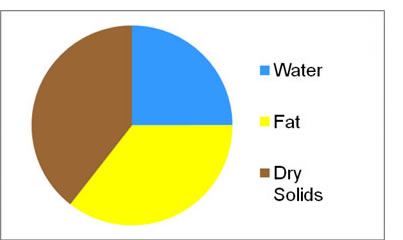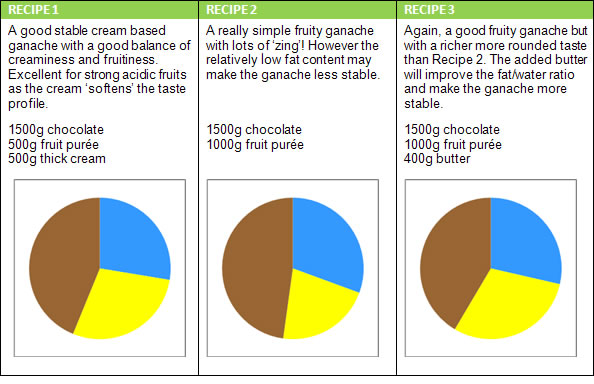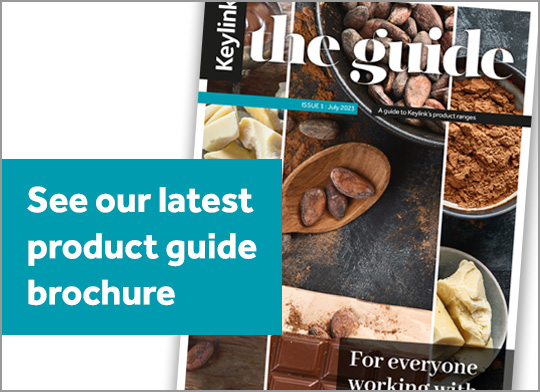Making a Fruit Ganache with Ravifruit Purées
Posted: 22 May 2015
Now is the time to be thinking about making some really fruity chocolates! But what recipe to use for your ganache? The fact is that there are a thousand different recipes and so there is no one “right” way to do it.
However there are some basic things to get right to ensure that your ganache is stable and that it has a balanced taste, a good consistency and mouth feel and a good shelf life.
What Is A Ganache?
Fundamentally, a ganache is a combination of chocolate and a liquid. Usually this liquid is cream but it could be a fruit purée or even wine or beer. The main ingredients of any ganache are therefore water, fat, sugars and dry substances.
 This diagram shows the ingredients of a typical, high-quality, creamy ganache where two-thirds of the fat is cocoa butter and the remaining one-third is butter (dairy) fat. Normally, the total fat content of a ganache would be between 25% and 40%. Sugar content should ideally be 75% of the water content.
This diagram shows the ingredients of a typical, high-quality, creamy ganache where two-thirds of the fat is cocoa butter and the remaining one-third is butter (dairy) fat. Normally, the total fat content of a ganache would be between 25% and 40%. Sugar content should ideally be 75% of the water content.
Since water and fat repel each other, the water/fat ratio is very important to ensure that you can have a good “emulsion”.
The dry matter and the sugars bring the taste profile and also help to emulsify the water and fat molecules. Sugars are also often added to extend shelf life as they act as moisture stabilisers.
Fruit Ganache Recipes
Here are three basic recipes, all of which will act as a good starting point which you can then adapt according to the taste profile and fat content of your chocolate, the acidity of the fruit, the shelf life required, etc.
In these recipes, we have assumed that the chocolate used is one of SCC501 (Callebaut 811 Dark), SCC521 (Callebaut 823 Milk) or SCC541 (Callebaut W2 White), all three of which have a total fat content of approximately 36%.
The average water content of the Ravifruit ambient fruit purées is 75% and that is what is assumed for the calculations. Similarly, we have assumed a 35% fat cream with a water content of 60%.

In each case, it is better not to boil or over-heat the purée as this can impair the flavour of the fruit. In the cream based ganache, just heat the cream, melt in the chocolate and fold in the purée. Alternatively, put all the ingredients into a microwaveable bowl and heat in short bursts in order to melt the chocolate without losing temper. If your ganache is tempered, it will be more stable.
RAVIFRUIT Fruit Purées
As Ravifruit’s new distributor for England and Wales, we are delighted to offer their full range of ambient fruit purées from stock. These purées are 100% natural and are of an exceptionally high quality which you really have to taste to believe! They have a 12 month shelf life (ambient below 15°c) from date of production and a 3 day shelf life (refrigerated) once opened.
There are a number of great advantages when using an ambient purée:
- You don’t need to use up your valuable freezer space for storage.
- You don’t need to worry about defrosting it before use.
They are all available in 1 litre Variopak cartons but if you don’t think you will use the full litre within three days, then you can simply freeze what you don’t think you’ll use in ice trays as soon as you open the carton and save it for another time. Click for details of all the ambient purée flavours.
We can also supply the full range of Ravifruit frozen products, but at present these can only be ordered in ‘full mixed pallet’ quantities. Please click for details of the whole Ravifruit range.
Shelf Life & Other Issues
Usually, the most important determinant of shelf life is the amount of ‘free’ or ‘available’ water (AW) in the ganache. If there is too much water, it can lead to separation of the fats and provide an environment for mould growth.
Water Activity (AW) is defined as the vapour pressure of water divided by that of pure water at the same temperature. In effect, it is a measure of the ‘free’ or ‘un-bonded’ water in a food product. The closer the AW is to 1, the more liable the product is to bacterial, fungal or mould growth. Typical AW values are 0.99 for raw meats, 0.95 for bread, 0.85 for cheese, 0.6 for dried fruit and 0.3 for biscuits. Solid chocolate has a very low AW and is therefore microbiologically stable. Bacteria usually require an AW of above 0.9 and most moulds require an AW of above 0.8. An AW of below 0.6 would prevent any microbiological spoilage at all and this is what is required if you want a 12 month shelf life at room temperature for your ganaches. To lower AW, you need either to remove water, or bind it using agents such as sugars, or lower the temperature of the product.
One common way of reducing the AW of your chocolate centres is to add sugars. There are many sugars that can be added and glucose and sorbitol are the most common. Each sugar has different characteristics and differing levels of sweetness, so you may need to use a combination of sugars to achieve the best overall results. For instance, sorbitol is very good at binding the water and it is only half as sweet as normal sugar (sucrose), but too much can have a laxative effect!
Adding Alcohol to your Fruit Ganache
Adding a fruit flavoured alcohol concentrate, such as strawberry liqueur, Calvados or Kirsch to your ganache will not only boost the fruitiness of the ganache, but also make it a really indulgent adult treat. Alternatively, you could use alcohols such as Cointreau, Passoa and St James Rum to make cocktail chocolates!
A further benefit of adding alcohol is that it will greatly increase shelf life by inhibiting mould growth. Remember that most concentrates still contain some water so you will probably have to replace some of the cream with the concentrate.
Click to see the full range of alcohol concentrates available from Keylink.
Further Reading
For further information, we would strongly recommend investing in Jean-Pierre Wybauw’s book “Fine Chocolate 2 – Great Ganache Experience” (Keylink Code SEB103). This book provides much more detailed and invaluable information on a number of subjects including:
- The basic components of a ganache
- Curdling (fat separation) and how to avoid it
- Factors affecting shelf life
- Different sugars and their uses.
The book also has a very large number of new recipes, with an AW value for each one. This is particularly helpful because it allows you to estimate the shelf life of each product.
Please note that all recipe guidance and advice is given in good faith and that there are a number of factors, including hygiene standards, that can affect the quality and stability of your ganache.
.svg)

 white.svg)